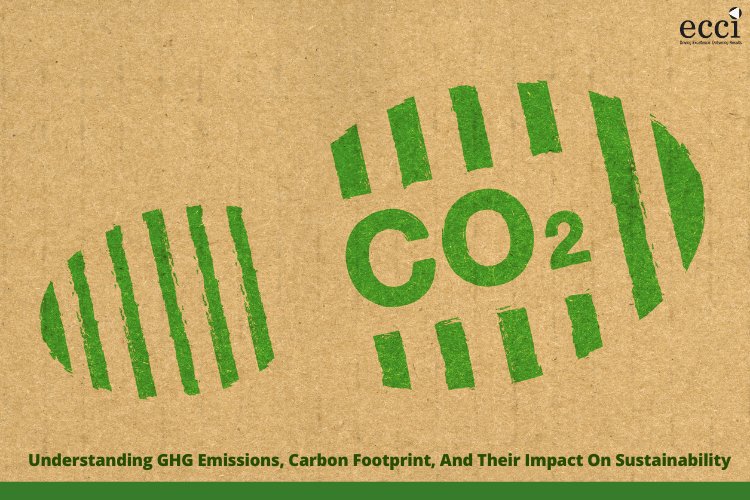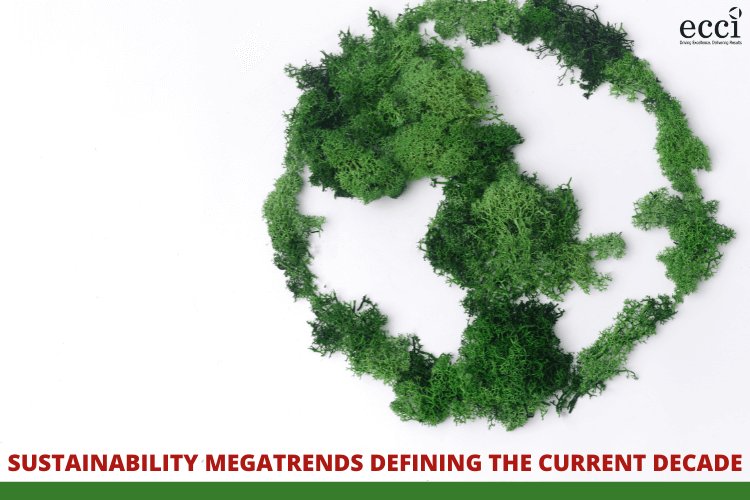Climate conferences, new regulations, and the escalating frequency of extreme weather events have everyone talking about the need to reduce our greenhouse gas (GHG) emissions. But are we all on the same page about what GHGs are, their causes and effects, and what we can do to manage them?
In this article, you will discover everything you need to know about GHGs, why you need to measure them, and how your organization can reduce your carbon footprint to help slow climate change. Ready to learn more? Let’s dive in!
What are GHGs?
GHGs are a group of gases in the earth’s atmosphere that absorb and trap heat from the sun. Without the presence of GHGs, the earth would not be able to sustain its liveable temperature. However, human activities, particularly deforestation, the burning of fossil fuels, and industrial processes have significantly increased the concentrations of these gases. As these GHGs accumulate in the atmosphere, they warm the climate, contributing to global warming and, ultimately, climate change.
GHGs and their sources
i. Carbon dioxide
Globally, carbon dioxide (CO2) is the main contributor to GHGs. It is emitted mainly by burning solid waste, trees, wood products, and fossil fuels. Soil degradation and deforestation also add CO2 to the atmosphere.
ii. Methane
Methane (CH4) is the second most-emitted greenhouse gas. It’s created during the production and transportation of coal, natural gas, and oil. It’s also emitted from agricultural practices, livestock, and the decay of organic waste.
iii. Nitrous oxide
Nitrous oxide (N2O) constitutes around four percent of the global GHG emissions. It is released during agricultural activities such as managing animal waste, industrial processes, the combustion of fossil fuels, and wastewater treatment.
iv. Fluorinated gases
Fluorinated gases are potent greenhouse gases released during various commercial, industrial, and household applications and processes. They are called as high global warming potential gases because of their capacity to trap substantially more heat than carbon dioxide for a given amount of mass.
v. Other gases
Other GHGs include water vapor and ozone (O3). Both are not directly emitted by human activity, and ground-level or tropospheric ozone emerges from complex reactions among pollutants in the air.
Key impacts of GHG emissions
The release of greenhouse gases and their accumulation in the earth’s atmosphere are already affecting the environment, human health, and the economy. These impacts will become more severe unless united efforts to reduce emissions are undertaken.
a) Environmental impact

Environmental impacts of GHG emissions include:
- A rise in global temperatures leading to intensification of heatwaves and wildfires.
- Escalating coastal flooding from sea level rise.
- Increased global precipitation leading to higher flood risks.
- More frequent droughts, especially in regions like the Mediterranean and northern Africa.
- Significant impacts on wildlife through wildfires.
b) Human health impact
Some effects of climate change on our health include:
- An increased risk of death from heat stroke and dehydration because of higher temperatures and severe extreme weather events.
- A greater risk of cardiovascular and respiratory problems and certain types of cancers as a result of increased air pollution.
- An increased chance of injury due to extreme weather events such as flooding and more destructive storms.
c) Economic impact
Some of the main economic impacts of climate change include:
- Changing weather patterns negatively affecting forestry, agriculture, and tourism.
- Human health impacts placing additional economic stress on health and social support systems.
- Damage to infrastructure due to extreme weather and rising sea levels.
- Lower agricultural yields caused by environmental changes.
- Increased heat and diseases causing lower rates of labor productivity.
Measuring GHG emissions
Whether you’re required to report your GHG emissions, you want to reduce your emissions, or you simply want to better understand your business’ impact on the environment, your first step is to measure your GHG emissions.
In 2015, under the Paris Agreement signed by 196 nations, countries collectively agreed to reduce their emissions with the goal of preventing global temperature increase beyond 2°C (with a preferred limit of 1.5°C) compared to pre-industrial levels. Every five years, participating nations submit a Nationally Determined Contribution (NDC), outlining their individual national climate action plans that include specific targets for reducing GHG emissions.
The Philippines submitted its first NDC in April 2021. It has committed to a projected reduction and avoidance of 75% in GHG emissions, with 2.71% being unconditional, for the period 2020 to 2030.
The success of the Paris Agreement relies on countries being transparent about verifying and reporting on the progress of their NDC implementation. Thus, numerous laws, policies, and regulations have been created in efforts to encourage organizations to track, disclose, and reduce their GHG emissions.
However, measuring your emissions isn’t just about following regulations and policies. It also makes good business sense for a number of reasons, including:
1. Increase investor confidence
Investors are aware that climate risks like floods and droughts can pose real financial risks to companies. So, they need reliable information to make informed investment decisions, and transparent emissions measurement & reporting go a long way toward building investor confidence.

2. Reduce costs
Measuring your organization’s GHG emissions enables you to identify inefficiencies, especially those in your value chain. By optimizing energy usage, streamlining operations, and collaborating with suppliers for emission reductions, businesses can increase their efficiency and cut down unnecessary costs.
3. Attract new talent
According to a report by Unily, almost two-thirds (65%) of survey participants said that they were more likely to work for a company with strong environmental policies. Human rights, climate change, and social equity are all issues that are becoming more and more important, especially for millennial employees, who now make up the majority of the workforce. Measuring and reporting your GHG emissions can, therefore, help you attract top talent and increase engagement among your current employees.
4. Meet customer expectations
Nowadays, consumers are becoming increasingly conscious of environmental and ethical considerations. As a result, there is a growing expectation for businesses to demonstrate their commitment to sustainability. By measuring and reporting their carbon footprint, organizations can communicate their carbon reduction efforts transparently to stakeholders and establish themselves as leaders in their respective industries.
Scope 1, 2, and 3 emissions
Greenhouse gas emissions, for the purposes of measurement, are categorized into 3 scopes: Scope 1, Scope 2, and Scope 3. These scopes were developed through the Greenhouse Gas Protocol, which seeks to harmonize the approach to corporate reporting worldwide. Let’s look at them in more detail below.
– Scope 1 emissions
These are direct emissions – those that an organization emits by operating the things that it owns or controls. These can be released as a result of running machinery to manufacture products, driving vehicles, or just heating buildings and powering computers.
– Scope 2 emissions
These are indirect emissions that are released during the production of the electricity or energy that an organization buys. Although these emissions occur at another facility and are outside the reporting company’s direct control, they are still accounted for in its GHG inventory because they are a result of the company’s energy use.
– Scope 3 emissions
Now, here’s where it gets tricky. These are also indirect emissions – meaning those not produced by the organization itself – but they differ from Scope 2 as they cover those produced by customers using the company’s products or those produced by suppliers making products that the company uses.
Scope 3 emissions are again divided into upstream and downstream emissions.
Upstream emissions are the indirect emissions related to a reporting organization’s suppliers, from the purchased materials that flow into the organization to the products and services the organization utilizes. Some examples are emissions released during business travel, disposal of waste generated in operations, employee commuting, and transportation of purchased goods and services.
Downstream emissions are the indirect emissions related to customers, from selling products and services to their distribution, use, and end-of-life stages. Some examples are emissions released during the transportation and distribution of sold products, processing of sold products, disposal of sold products, and franchise operations.
Companies can normally easily measure their Scope 1 and 2 emissions and can control them by taking steps like switching to renewable energy or electric vehicles.
But Scope 3 emissions are under the control of suppliers or customers, so they are affected by decisions made outside the company.
That means measuring Scope 3 emissions involves tracking activities across the entire business model – or value chain – from suppliers to end users.
How can businesses reduce their carbon footprint?
The UNEP’s Emissions Gap Report 2023 states that predicted 2030 global GHG emissions must fall by 42 percent in order to achieve the Paris Agreement’s 1.5°C goal.
Organizations can do their part by taking steps to reduce their carbon footprint. Here are five important actions businesses need to prioritize for maximum impact:
A. Conduct a comprehensive emission audit
The first action is conducting a thorough emission audit to identify and quantify the various sources of GHG emissions within your operations. This foundational step provides crucial insights into where your organization’s emissions originate and sets the stage for targeted reduction strategies.
In order to accurately measure your carbon footprint, it is recommended to follow the guidelines of internationally recognized standards for GHG emission calculation and management, like the GHG Protocol’s Standards, and IPCC’s 2019 refinement report to the 2006 IPCC guidelines. These standards enable businesses to effectively contribute to their emission reduction goals, aligning organizations with global efforts to combat climate change.
B. Set emission reduction targets
After measuring your organization’s emissions, you can start setting clear and measurable emissions reduction targets. To achieve meaningful results, many organizations are now turning to Science-Based Targets (SBTs). SBTs are grounded in the latest climate science and are created to align with the global goal of limiting Earth’s temperature rise to 1.5°C above pre-industrial levels. Thus, by setting SBTs and taking steps to achieve them, businesses can contribute meaningfully to climate action and position themselves as leaders in sustainability. Learn more about SBTs and how to get started on the SBT path here.
C. Implement reduction strategies
With clear GHG emission reduction targets in place, the next important step is to implement effective reduction strategies to achieve these targets. This phase requires commitment, collaboration, and a multifaceted approach that addresses all 3 scopes of emissions. To reduce your Scope 1 emissions, you can focus on improving your operational efficiency and transitioning to renewable energy sources. For Scope 2 reductions, you should start adopting cleaner energy and improving your energy efficiency. For Scope 3 reductions, you can collaborate with suppliers to reduce emissions along the entire value chain, optimize your employee transportation, and make your products and packaging recyclable.
D. Offset unavoidable emissions
Along with putting efforts into reducing your emissions, you can also implement various carbon offsetting initiatives to balance out the unavoidable environmental impact of your business operations. This involves investing in projects that either capture or reduce emissions elsewhere, like reforestation & afforestation, renewable energy development, waste & landfill management, etc. By offsetting their emissions, organizations can take immediate action to neutralize their carbon impact while working on longer-term emission reduction goals. It’s essential, however, to approach carbon offsetting as an additional action rather than a substitute for direct emissions reduction efforts.
E. Regularly monitor and report your emissions
In addition to your carbon reduction and offsetting efforts, you should also regularly monitor and report your GHG emissions. By regularly assessing and comparing performance against predefined emission reduction targets, businesses can identify areas for improvement, refine their strategies, set more ambitious goals, and stay ahead of emerging sustainability trends.
Reporting involves transparently communicating your emission data to various internal and external stakeholders. Publicly disclosing emissions data encourages organizations to adopt best practices and continuously improve their environmental performance. It also allows stakeholders to assess the organization’s progress toward sustainability goals.
Conclusion
When it comes to climate change, action is necessary on governmental, organizational, and individual levels. Businesses measuring their GHG emissions and setting up a reduction strategy are not just doing their part in this story. Additionally, it also allows them to seize many opportunities and get through the transition with enhanced resilience and strength.
The benefits of measuring emissions are there for companies of all sizes. Bigger enterprises might have more resources to set up a climate strategy. However, smaller firms have the advantage of less complex value chains, which allows for quick fixes.
A good starting point for corporate climate action is quantifying your organization’s GHG emissions, understanding your impact, and assessing your risks. From there, it is important to continue by setting out a reduction strategy and start implementing it.
So, when is your organization going to get started?
ECCI is here to guide you on this transformative journey. Our team of experts can assist you in identifying the sources of carbon emissions, measuring your organization’s impact on climate change through carbon footprint assessment, and offsetting your emissions to make your organization carbon-neutral.
To start your journey, simply get in touch with us and enjoy a free advisory session. Visit our webpage for more information on how we can help you.









